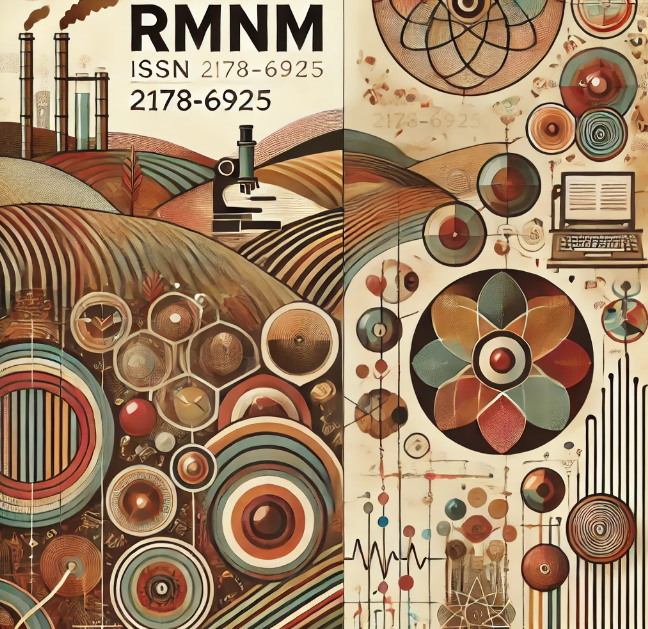DETERMINATION OF ARTIFICIAL COLORS IN FOOD BY COLORIMETRY BASED ON DIGITAL.
DOI:
https://doi.org/10.61164/rmnm.v6i1.2473Keywords:
Colorimetria, RGB, Corantes artificiaisAbstract
Colors are one of the sensorial characteristics associated by the consumer as they influence the quality, flavor, sensation of sweetness, and food preference. It is still a decisive factor in the choice of food, based on this the food industry uses colors to please the consumer's eyes. The present work proposed to demonstrate the feasibility of using digital images for the purpose of analyzing food colorings and subsequently compare its results with those obtained by molecular absorption spectrophotometry in the UV-Vis region. Initially, some tests were carried out with green and yellow dyes to demonstrate the application of the proposed method. The absolute relative error using an RGB image sensor for the analyzed samples was 4.0% for the green dye and 2.5% for the yellow dye. Next, 3 samples of powdered juice were analyzed, in which the tartrazine dye levels obtained by the proposed method and the spectrophotometric method were within the limit established by Brazilian legislation for tartrazine.
References
ANASTÁCIO, Lucas de Barros; OLIVEIRA, Danielle Aparecida; DELMASCHIO, Camila Rocha; ANTUNES, Lusânia Maria Greggi; CHEQUER, Farah Maria Drumond. Corantes alimentícios amaranto, eritrosina B e tartrazina, e seus possíveis efeitos maléficos à saúde humana. Journal of Applied Pharmaceutical Sciences, 2016.
BRASIL. Agência Nacional de Vigilância Sanitária - ANVISA, Compêndio da Legislação Brasileira de Aditivos Alimentares. In: Diário Oficial da República Federativa do Brasil B, DF., ed; 2011.
CONSTANT, PATRÍCIA BELTRÃO LESSA; STRINGHETA, Paulo Cesar; SANDI, Delcio. Corantes alimentícios. Boletim do Centro de Pesquisa de Processamento de Alimentos, v. 20, n. 2, 2002.
COSTA, Lara Farias Lustosa da et al. CORANTES ARTIFICIAIS PERMITIDOS NO BRASIL: PRINCIPAIS CARACTERÍSTICAS E EFEITOS TOXICOLÓGICOS. Ciência e Tecnologia de Alimentos: Pesquisa e Práticas Contemporâneas, v. 2, n. 1, p. 428-444, 2021.
GOMES, M. S.; TREVIZAN, L. C.; NÓBREGA, J. A. Uso de Scanner em Espectrofotometria de Absorção Molecular: Aplicação em Experimento Didático Enfocando a Determinação de Ácido Ascórbico. Química. Nova, v. 31, p. 1577-1581, 2008.
MACHADO, A. W.; SOUKI, B. Q. Simplificando a obtenção e a utilização de imagens digitais - scanners e câmeras digitais. R Dental Press Ortodon Ortop Facial, v. 9, p. 133-156, 2004.
PRADO, M. A.; GODOY, H.T. Determinação de corantes artificiais por cromatografia líquida de alta eficiência (CLAE) em pó para gelatina. Química. Nova, v. 27, p. 22-26, 2004.
PRADO, M.A.; GODOY, H.T. Teores de corantes artificiais em alimentos determinados por cromatografia líquida de alta eficiência. Química Nova, v. 30, no 2, p. 268-273, 2007.
RODRIGUES, P. D. S. Estudo do uso de corantes artificiais em alimentos e estimativa de ingestão de tartrazina pela população brasileira. 2015.
SAMPAIO, Asaf Hanâni Taveira. Corantes artificiais x corantes naturais: uma visão gastronômica. 2019.
TAKAHASHI, M.Y. YABIKU, H.Y e MARSIGLIA,D.A.P. Determinação quantitativa de corantes artificiais em alimentos. Rev. Inst. Adolfo Lutz, 48(1/2): 7-15, 1988.
TAKASHIMA, K., TAKATA, N. H., & NAKAMURA, W. M. Separação e identificação de corantes sintéticos para fins alimentícios solúveis em água. Semina: Ciências Exatas e Tecnológicas, v. 9, no 4, p.171 -- 174, 2004.
VIDOTTI, E. C. ROLLEMBERG, M. do C. E. Espectrofotometria derivativa: uma estratégia simples para a determinação simultânea de corantes em alimentos. Química Nova, v. 29, no 2, p. 230-233, 2006.
ZANONI, M. V. B.; YAMANAKA, H. (Orgs.). Corantes: caracterização química, toxicológica, métodos de detecção e tratamento. São Paulo: Cultura Acadêmica, p. 344, 2016.
Downloads
Published
How to Cite
Issue
Section
License
Copyright (c) 2024 Revista Multidisciplinar do Nordeste Mineiro

This work is licensed under a Creative Commons Attribution-NonCommercial-ShareAlike 4.0 International License.




